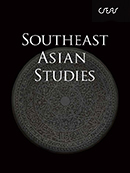7 巻, 2 号
選択された号の論文の12件中1~12を表示しています
- |<
- <
- 1
- >
- >|
Articles
-
2018 年 7 巻 2 号 p. 159-181
発行日: 2018年
公開日: 2018/08/23
PDF形式でダウンロード (566K) -
2018 年 7 巻 2 号 p. 183-197
発行日: 2018年
公開日: 2018/08/23
PDF形式でダウンロード (539K) -
2018 年 7 巻 2 号 p. 199-236
発行日: 2018年
公開日: 2018/08/23
PDF形式でダウンロード (6224K)
Book Reviews
-
2018 年 7 巻 2 号 p. 237-240
発行日: 2018年
公開日: 2018/08/23
PDF形式でダウンロード (515K) -
2018 年 7 巻 2 号 p. 240-243
発行日: 2018年
公開日: 2018/08/23
PDF形式でダウンロード (462K) -
2018 年 7 巻 2 号 p. 243-246
発行日: 2018年
公開日: 2018/08/23
PDF形式でダウンロード (462K) -
Sari K. Ishii, ed. Marriage Migration in Asia: Emerging Minorities at the Frontiers of Nation-States2018 年 7 巻 2 号 p. 246-250
発行日: 2018年
公開日: 2018/08/23
PDF形式でダウンロード (466K) -
2018 年 7 巻 2 号 p. 250-254
発行日: 2018年
公開日: 2018/08/23
PDF形式でダウンロード (466K) -
2018 年 7 巻 2 号 p. 254-257
発行日: 2018年
公開日: 2018/08/23
PDF形式でダウンロード (462K) -
2018 年 7 巻 2 号 p. 257-260
発行日: 2018年
公開日: 2018/08/23
PDF形式でダウンロード (462K) -
2018 年 7 巻 2 号 p. 261-264
発行日: 2018年
公開日: 2018/08/23
PDF形式でダウンロード (491K) -
2018 年 7 巻 2 号 p. 264-266
発行日: 2018年
公開日: 2018/08/23
PDF形式でダウンロード (472K)
- |<
- <
- 1
- >
- >|
